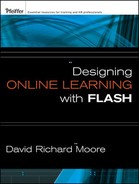M.J. Adler (1977). Reforming education. New York: Macmillan.
Adobe. (2008). Flash. www.adobe.com/products/flash/features/, accessed on January 9, 2008.
T.A. Anglelo, & P.K. Cross (1993). Classroom assessment techniques: A handbook for college teachers. San Francisco: Jossey-Bass.
American Physiology Institute. (2007). Technical writing skills. Retrieved Aug. 9, 2007, from www.the-aps.org/careers/careers1/GradProf/gwriting.htm
M.H. Ashcraft (1989). Human memory and cognition. New York: HarperCollins.
D. Ausubel (1963). The psychology of meaningful verbal learning. New York: Grune & Stratton.
D.P. Ausubel (2000). The acquisition and retention of knowledge: A cognitive view. New York: Springer.
J.E. Brophy (1988). Educating teachers about managing classrooms and students. Teaching and Teacher Education, 4, 1, 3.
R.E. Clark (1983). Reconsidering research on learning from media. Review of Educational Research, 53(4), 445–459.
J. Clement (1987). Overcoming students' misconceptions in physics: The role of anchoring intuitions and analogical validity. In J.D. Novak (Ed.), Proceedings of the second international seminar on misconceptions and educational strategies in science and mathematics. Ithaca, NY: Cornell University.
E. Dale (1969). Audiovisual methods in teaching (3rd ed.). New York: The Dryden Press; Holt, Rinehart and Winston.
D.C. Dennet (1995). Darwin's dangerous idea: Evolution and the meanings of life. New York: Touchstone.
M. Fleming, & W.H. Levie (1993). Instructional message design: Principles from the behavioral and cognitive sciences (2nd ed.). Englewood Cliffs, NJ: Educational Technology Publications.
R.M. Gagné (1985). The conditions of learning and theory of instruction (4th ed.). New York: Harcourt Brace.
P. Galagan (2003). The future of the profession formerly known as training. Accessed www.astd.org/NR/rdonlyres/6D3A9759-DCA4-4627-B2E1-0CEF6B4D28AC/0/76031226.pdf, November 15, 2007.
G.L. Gropper (1974). Instructional strategies. Englewood Cliffs, NJ: Educational Technology Publications.
G.L. Gropper (1983). A behavioral approach to instructional prescription. In C.M. Reigeluth (Ed.), Instructional-design theories and models, volume I (pp. 101–161). Mahwah, NJ: Lawrence Erlbaum Associates.
M.J. Hannifin, & S.R. Hooper (1993). Learning principles. In M. Fleming & W.H. Levie, Instructional message design. Englewood Cliffs, NJ: Educational Technology Publications.
D. Hanson, & N. Maushak (1996). Distance education: Review of the literature (2nd ed.). Ames, IA: Research Institute for Studies in Education.
E.B. Hunt (1962). Concept learning: An information processing problem. Hoboken, NJ: John Wiley & Sons.
N.M. Hogg (2006). Measuring cognitive load. In R.A. Reynolds, R. Woods, & J. Baker (Eds.), Handbook of research on electronic surveys and measurements (pp. 188–194). Hershey, PA: Idea Group Reference.
D.H. Jonassen, M. Tessmer, & W.H. Hannum (1999). Task analysis methods for instructional design. Mahwah, NJ: Lawrence Erlbaum Associates.
P.A. Kirschner, J. Sweller, & R.E. Clark, (2006). Why minimal guidance during instruction does not work: An analysis of the failure of constructivist, discovery, problem-based, experiential, and inquiry-based teaching, Educational Psychologist, 41(2), 75–86.
B. Lockee, J. Burton, & L. Cross (1999). No comparison: Distance education finds a new use for "no significant difference." Educational Technology Research and Development, 47(3), 33–42.
L.L. Lohr (2007). Creating graphics for learning and performance: Lessons in visual literacy (2nd ed.). Englewood Cliffs, NJ: Prentice Hall.
R.F. Mager (1961). Preparing instructional objectives. Belmont, CA: Fearon.
M.D. Merrill (1983). Component display theory, In C.M. Reigeluth (Ed.), Instructional-design theories and models: An overview of their current status. Mahwah, NJ: Lawrence Erlbaum Associates.
M.D. Merrill (1997, November/December). Instructional strategies that teach. CBT Solutions, pp. 1–11.
M.D Merrill, L.D. Drake, M.J. Lacy, J.A. Pratt, & the ID2 Research Group. (1996). Reclaiming instructional design. Educational Technology, 36(5), 5–7.
G.A. Miller (1956). The magical number seven, plus or minus two: Some limits on our capacity for processing information. Psychological Review, 63, 81–97.
D.R. Moore, & B.B. Lockee (2000). Design strategies for web training: Using bandwidth effectively. (pp. 271–274). In B. Khan (Ed.), Web-based training. Englewood Cliffs, NJ: Educational Technology Publications.
E.H. Mory (1996). Feedback research. In D.H. Jonassen (Ed.), Handbook of research for educational communications and technology (pp. 919–956). New York: Macmillan.
I. Newton, (1999). The Principia. [I.B. Cohen & A. Whitman, trans.] Berkeley, CA: University of California Press.
A. Rand (1990). Introduction to objectivist philosophy. In H. Binswanger & L. Peikoff (Eds.), The objectivist forum (2nd ed.). New York: Meridian.
L.E. Richland, K.J. Holyoak, & J.W. Stigler (2004). Analogy use in eighth-grade mathematics classrooms. Cognition and Instruction, 22(1), 37–60.
E. Rosch (1999). Reclaiming concepts. Journal of Consciousness Studies, 6, pp. 11–12, 61–77.
M.J. Rosenberg (2000). e-Learning: Strategies for delivering knowledge in the digital age. New York: McGraw-Hill.
E. Sallis, & G. Jones (2002). Knowledge management in education: Enhancing learning and education. London: Routledge.
T. Sivasailam (2007). Rapid instructional design. Accessed from www.thiagi.com/article-rid.html, November 15, 2007.
B.F. Skinner (1953). Science and human behavior. New York: Macmillan.
Sloan. (2008). www.sloan-c.org/publications/survey/index.asp.
P.L. Smith, & T.J. Ragan (2005). Instructional design. Hoboken, NJ: John Wiley & Sons.
E.L. Thorndike (1911). Animal intelligence. New York: Macmillan.
S. Tobias (1993). Overcoming math anxiety. New York: W.W. Norton & Company.
J.J.G. Van Merrienboer (1999). Cognition and multimedia design for complex learning: Inaugural address. Open University of the Netherlands, July 1, 1999.
L.S. Vygotsky (1978). Mind and society: The development of higher psychological processes. Cambridge, MA: Harvard University Press.
Wikihow, (2007). How to perform the heimlich maneuver. Accessed December 12, 2007, at www.wikihow.com/Perform-the-Heimlich-Maneuver.
Wikipedia. (2007). Future value. Retrieved August 21, 2007, from http://en.wikipedia.org/wiki/Future_value.
Wikipedia. (2007). Keelboat. Retrieved August 21, 2007, from http://en.wikipedia.org/wiki/Keelboat.
Wikipedia. (2007). Newton's laws. Retrieved August 21, 2007, from http://en.wikipedia.org/wiki/Newton's_laws_of_motion.
Wikipedia. (2007). Schooner. Retrieved August 21, 2007, from http://en.wikipedia.org/wiki/Schooner.
Wikipedia. (2007). Vector. Retrieved August 18, 2007, from http://en.wikipedia.org/wiki/Vector.
E. Winters (2008). Glossary. www.ewinters.com/Glossary.html accessed on January 9, 2008.
S. Wu (2007, May). Rethinking blackened red snapper. Cook's Illustrated.
D. Wood, J. Bruner, & G. Ross (1976). The role of tutoring in problem solving. Journal of Child Psychology and Psychiatry, 17, 89–100.
J. Zull (2002). The art of changing the brain: Enriching the practice of teaching by exploring the biology of learning. Sterling, VA: Stylus.
